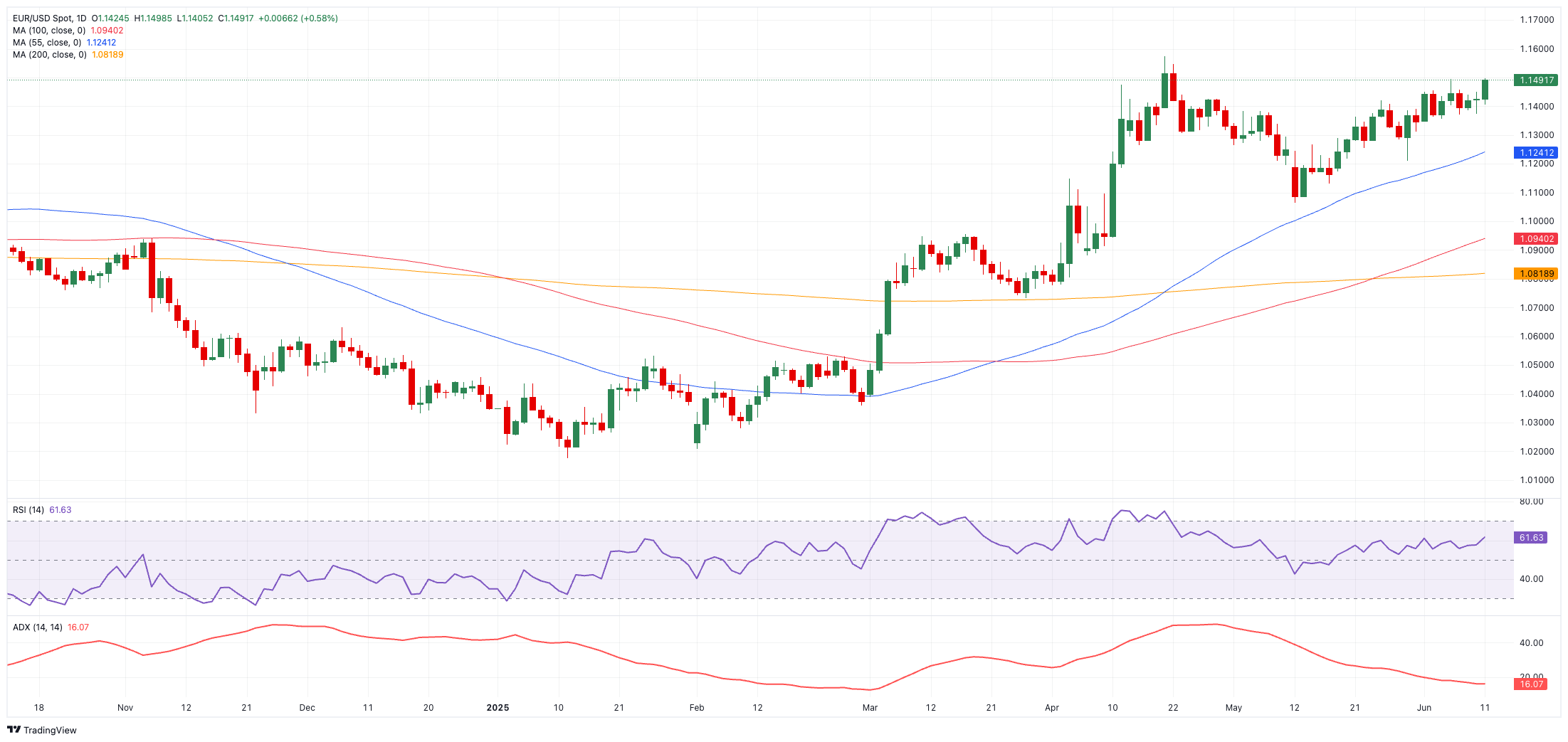
- EUR/USD flirted with the 1.1500 barrier, or four-day peaks, on Wednesday.
- The US Dollar deflated to multi-day lows on disheartening US CPI prints.
- A rate cut by the Fed in September gathers traction following US inflation data.
On Wednesday, the Euro (EUR) continued its weekly upward trend, trading just below monthly highs against a broadly depressed US Dollar (USD).
Indeed, EUR/USD rose to multi-day peaks in the boundaries of 1.1500 the figure, while the US Dollar Index (DXY) extended further its breach below the 99.00 support amid a widespread decline in US Treasury yields.
Trade truce in focus
US and Chinese officials have been discussing a potential trade agreement since Monday in London.
On this, President Donald Trump said the US–China agreement was “done” a day after officials from Washington and Beijing agreed on a framework to renew their trade ceasefire. He said that Beijing has promised to provide magnets and rare earth materials as part of the accord.
The White House says that the pact lets the US put a 55% tax on Chinese goods. This includes a 10% “reciprocal” tax, a 20% tax on fentanyl trafficking, and a 25% tax on trade barriers that are already in place. In retaliation, China would charge a 10% tax on goods coming into the country from the US.
Divergent monetary paths
Other than global trade and tariff effervescence, central bank policy differences should continue to underpin currency moves.
That said, in May, the Federal Reserve (Fed) held interest rates steady and signalled a data-driven approach, with markets increasingly pricing in a potential rate cut by September as inflation cools.
Conversely, last Thursday the European Central Bank (ECB) cut its deposit rate by 25 basis points to 2.00%, but President Christine Lagarde struck a relatively hawkish tone. With stronger-than-expected growth forecasts and no hint of further easing, Lagarde emphasised that only a “significant escalation” in trade tensions would alter the ECB’s cautious stance.
Speculators back the Euro
CFTC figures through June 3 showed net long positions in EUR rising to a three-week high of roughly 82.8K contracts, while overall open interest climbed above 781K contracts, the strongest level in three years. Commercial hedgers increased their short positions to nearly 138.3K contracts, underscoring growing institutional demand for Euro downside protection.
Technical outlook
EUR/USD remains well above its 200-day simple moving average (SMA) at 1.0825, preserving the broader uptrend.
Immediate resistance sits at the YTD high of 1.1572 (April 21), followed by the 1.1600 milestone and the October 2021 peak of 1.1692 (October 28).
On the downside, interim support lies at the 55-day SMA at 1.1250, ahead of the weekly trough of 1.1210 (May 29) and the May floor of 1.1064 (May 12).
Momentum indicators paint a mixed picture: the Average Directional Index (ADX) near 16 signals a weakening trend, while the Relative Strength Index (RSI) nearly 62 points to ongoing bullish bias.
What’s Ahead
Eurozone investors will turn their attention to ECB speakers, including Isabel Schnabel, Luis De Guindos, and Frank Elderson on June 12, as well as Germany’s final inflation data on June 13 and subsequent EMU Balance of Trade results, and Industrial Production figures.

Euro FAQs
The Euro is the currency for the 19 European Union countries that belong to the Eurozone. It is the second most heavily traded currency in the world behind the US Dollar. In 2022, it accounted for 31% of all foreign exchange transactions, with an average daily turnover of over $2.2 trillion a day. EUR/USD is the most heavily traded currency pair in the world, accounting for an estimated 30% off all transactions, followed by EUR/JPY (4%), EUR/GBP (3%) and EUR/AUD (2%).
The European Central Bank (ECB) in Frankfurt, Germany, is the reserve bank for the Eurozone. The ECB sets interest rates and manages monetary policy. The ECB’s primary mandate is to maintain price stability, which means either controlling inflation or stimulating growth. Its primary tool is the raising or lowering of interest rates. Relatively high interest rates – or the expectation of higher rates – will usually benefit the Euro and vice versa. The ECB Governing Council makes monetary policy decisions at meetings held eight times a year. Decisions are made by heads of the Eurozone national banks and six permanent members, including the President of the ECB, Christine Lagarde.
Eurozone inflation data, measured by the Harmonized Index of Consumer Prices (HICP), is an important econometric for the Euro. If inflation rises more than expected, especially if above the ECB’s 2% target, it obliges the ECB to raise interest rates to bring it back under control. Relatively high interest rates compared to its counterparts will usually benefit the Euro, as it makes the region more attractive as a place for global investors to park their money.
Data releases gauge the health of the economy and can impact on the Euro. Indicators such as GDP, Manufacturing and Services PMIs, employment, and consumer sentiment surveys can all influence the direction of the single currency. A strong economy is good for the Euro. Not only does it attract more foreign investment but it may encourage the ECB to put up interest rates, which will directly strengthen the Euro. Otherwise, if economic data is weak, the Euro is likely to fall. Economic data for the four largest economies in the euro area (Germany, France, Italy and Spain) are especially significant, as they account for 75% of the Eurozone’s economy.
Another significant data release for the Euro is the Trade Balance. This indicator measures the difference between what a country earns from its exports and what it spends on imports over a given period. If a country produces highly sought after exports then its currency will gain in value purely from the extra demand created from foreign buyers seeking to purchase these goods. Therefore, a positive net Trade Balance strengthens a currency and vice versa for a negative balance.
Information on these pages contains forward-looking statements that involve risks and uncertainties. Markets and instruments profiled on this page are for informational purposes only and should not in any way come across as a recommendation to buy or sell in these assets. You should do your own thorough research before making any investment decisions. FXStreet does not in any way guarantee that this information is free from mistakes, errors, or material misstatements. It also does not guarantee that this information is of a timely nature. Investing in Open Markets involves a great deal of risk, including the loss of all or a portion of your investment, as well as emotional distress. All risks, losses and costs associated with investing, including total loss of principal, are your responsibility. The views and opinions expressed in this article are those of the authors and do not necessarily reflect the official policy or position of FXStreet nor its advertisers. The author will not be held responsible for information that is found at the end of links posted on this page.
If not otherwise explicitly mentioned in the body of the article, at the time of writing, the author has no position in any stock mentioned in this article and no business relationship with any company mentioned. The author has not received compensation for writing this article, other than from FXStreet.
FXStreet and the author do not provide personalized recommendations. The author makes no representations as to the accuracy, completeness, or suitability of this information. FXStreet and the author will not be liable for any errors, omissions or any losses, injuries or damages arising from this information and its display or use. Errors and omissions excepted.
The author and FXStreet are not registered investment advisors and nothing in this article is intended to be investment advice.







